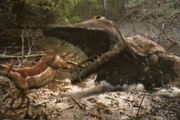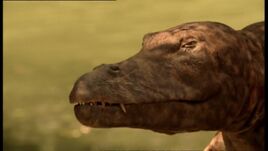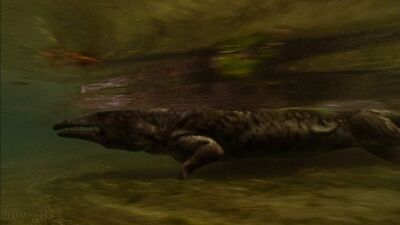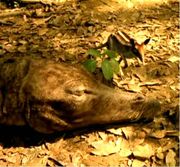Ambulocetus ("Walking Whale") was a bizarre prehistoric cetacean featured in the Impossible Pictures series Walking with Beasts.

Ambulocetus attacking Propalaeotherium
Facts
Although they are predators, these three–meter–long carnivores waddled awkwardly on land but are more agile in the water.
It lived in Germany 49 MYA, during the Eocene. Due to its crocodillian-like appearance, it most likely hunted as the crocodillians do - by ambush. On land, it was probably more sluggish than in water.
Although their ancestors hunted on land, Ambulocetus have evolved to be far more at home in the water. In fact, their descendants took this water life to an even greater extreme. Although these predators look a bit like crocodiles, they are actually the ancestor of the whales.
Their style of swimming looked like a whale or a dolphin - Ambulocetus was known to have their bodies swum up and down and not side to side like the fishes or crocodiles their shared their waters with.
Although these creatures have no ears, Ambulocetus listen for approaching prey by putting their jaws to the ground and detecting vibration. It is the same mechanism that allows them to hear underwater. Their killing techniques are simple. Their vise-like jaws hold the struggling prey until it drowns.
These creatures were among the most powerful predator in their territories. They often prepare ambushes near the shores of lakes and oceans.

Ambulocetus animatronic used
In Walking with Beasts
New Dawn
It is first seen by a Leptictidium that was hunting. Then the Ambulocetus attacked a Propalaeotherium with failure.
Later it decided to hunt on land for smaller prey. It got the perfect chance when a female Gastornis ambushed a herd of Propalaeotherium and a Lepticticium fled with her litter away in the commotion. The

Ambulocetus in the water
Ambulocetus snapped at them all, but was all in vain.
The Ambulocetus finally got a spot of luck when it hunted at night and killed a lone creodont by the lake. After finishing its meal, the Ambulocetus went up to the surface to sleep.
The Ambulocetus died that night from a cloud of poisonous gas (methane) that exploded from the lake that night. However, the episode's narration ends with a more optimistic note for this animal as the Leptictidium and her kind (that survived the earth tremor) are destined to become extinct when the world gets cooler and dryer and the forests start to disappear. The Ambulocetus however will go on as it will evolve into whales, "the most magnificent dynasty of mammals" that is discussed deeply in the next episode, Whale Killer.

Dead Ambulocetus.
Behind the scenes
Ambulocetus was erroneously depicted living in Germany, Europe. In reality, Ambulocetus lived in Pakistan, Asia where its fossils were found, although the series do say it likely migrated from its' true home.
Ambulocetus was actually a fairly clumsy swimmer, not really maneuverable or fast.
The creators used otters as a reference for the swimming of Ambulocetus.
Recent studies show that Ambulocetus was fully aquatic like modern whales, making its name ironic.
|
Ambulocetus • Basilosaurus • Cetotherium • Dorudon • Odobenocetops |
Template:Walking with Beasts Creatures
